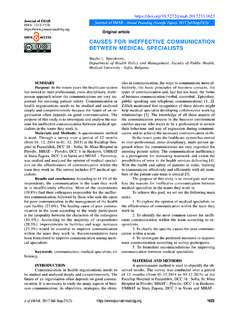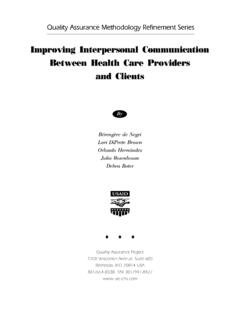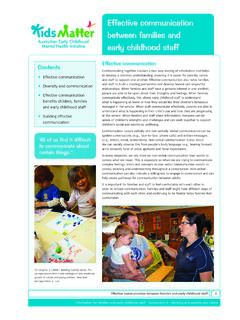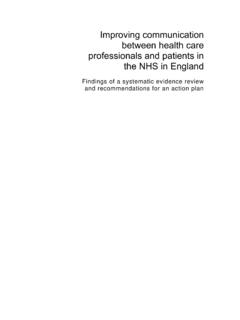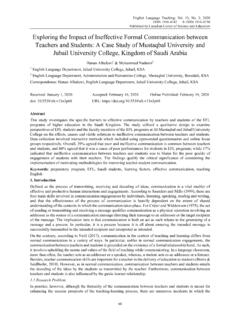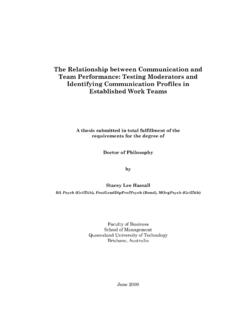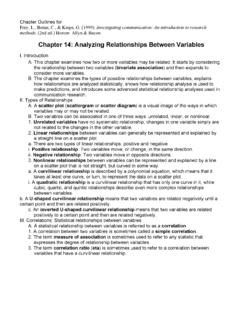Transcription of Communication and Coordination Between Employers
1 E M E R G E N C Y T E M P O R A R Y S T A N D A R D Communication and Coordination Between Employers As part of OSHA s COVID-19 Healthcare Emergency Temporary Standard (ETS), when employees of different Employers share the same physical location, each employer must: Communicate their COVID-19 plan to other Employers and coordinate to ensure that their employees are adequately protected, and Adjust their COVID-19 plan to address any COVID-19 hazards presented by the other employees. Note that these requirements do not apply to delivery people, messengers, and other employees who enter a workplace only briefly to drop off or pick up items. In addition, any employer with one or more employees working in a physical location that is controlled by another employer must notify the controlling employer when those employees are exposed to conditions at that location that do not meet the requirements of the ETS.
2 Good Communication is important to ensure that different Employers COVID-19 plans work together and minimize worker exposure to COVID-19. Consider using the following questions as part of your discussions to help ensure that needed information is shared and that your plan is sufficiently protective. Questions to ask when coordinating COVID-19 plans with other Employers Question Response Can you provide a written copy of your COVID-19 plan? When can we discuss Coordination of employee protections? Who are the safety coordinators? Will they serve as our liaisons? How do they contact each other ( , phone numbers, email addresses)? What has your workplace hazard assessment revealed? What are your policies and procedures for limiting and monitoring points of entry to settings where direct patient care is provided, and for screening and triaging patients and other non-employees entering the setting for symptoms of COVID-19?
3 Questions to ask when coordinating COVID-19 plans with other Employers Question Response Are there well-defined areas of the workplace where fully vaccinated employees are exempt from masking, distancing, and barrier requirements because there is no reasonable expectation that any person with suspected or confirmed COVID-19 will be present? If so, what are your policies and procedures for determining employees vaccination status? Are there areas or tasks where physical distancing is not feasible? Are there areas or tasks where facemasks are not used? Are there areas or tasks that require respirators? Can any work be done remotely? Are there physical barriers in place at fixed workstations outside of patient care areas where each employee is not separated from all other people by at least 6 feet when indoors?
4 (Note: physical barriers are not required in direct patient care areas or resident rooms.) What are your methods for improving ventilation? What are your procedures for cleaning and disinfection? Have you provided alcohol-based hand rub that is at least 60% alcohol or provided readily available handwashing facilities? How do you screen for possible cases of illness among employees? Who should we notify if we identify an employee who is COVID-19 positive? How will you notify us if you identify an employee who is COVID-19 positive? Questions to ask when coordinating COVID-19 plans with other Employers Question Response What procedures do you have in place for medical removal of an employee who has or is suspected to have COVID-19, is experiencing certain COVID-19 symptoms, or has been in close contact in the workplace with someone who has COVID-19?
5 How are you conducting COVID-19 training of employees? Can you share your training materials? What procedures do you have in place to support employee vaccination? Is there additional information we should provide to our employees? This document is intended to provide information about the COVID-19 Emergency Temporary Standard. The Occupational Safety and Health Act requires Employers to comply with safety and health standards promulgated by OSHA or by a state with an OSHA-approved state plan. However, this document is not itself a standard or regulation, and it creates no new legal obligations. 1-800-321-OSHA (6742) | TTY 1-877-889-5627 | OSHA 4134-06 2021










